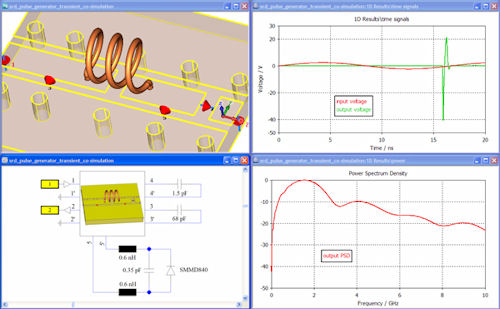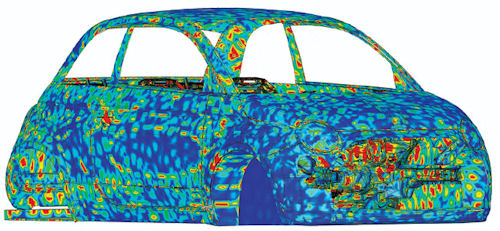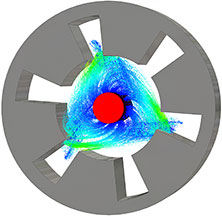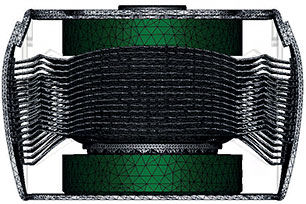Upgraded Simulation Toolset for Electromagnetics Ships
CST STUDIO SUITE 2013 features new ribbon interface, enhanced performance, and new analysis tools.
Latest News
May 1, 2013
 Projects created with the different CST electromagnetic simulation applications can be opened in CST STUDIO SUITE simultaneously. Image courtesy of Computer Simulation Technology AG. |
CST STUDIO SUITE is made up of six modules that form an integrated design environment providing an array of technologies and capabilities for electromagnetic design across a wide range of frequencies—static to optical. Analyses can include thermal and mechanical effects as well as circuit simulation. With version 2013, the company highlights changes to its CST MICROWAVE STUDIO module as well as general changes that span across the entire suite.
CST says that version 2013’s new ribbon-based user interface focuses on the simulation workflow to help lead the engineer from set-up and modeling to simulation and post-processing. Other new features, such as a Project Wizard and QuickStart Guide, augment the ribbon interface and make preparing and configuring new projects straightforward, the company says.
 The general-purpose transient solver in CST MICROWAVE STUDIO provides 3D EM simulations. Shown here are the surface currents excited by an in-vehicle antenna. Image courtesy of Computer Simulation Technology AG. |
Beyond the ribbon-based user interface, general enhancements incorporated in CST STUDIO 2013 include automatic storage of parametric results and cylinder scans for farfields of all solvers. The company adds that, through collaboration with Intel, its solver code has been optimized to boost performance when the software is run on Intel’s latest generation of processors.
CST MICROWAVE STUDIO (CST MWS) provides time and frequency domain solvers for 3D simulations of high frequency devices such as antennas, filters, couplers, and planar and multi-layer structures. The company reports a number of changes to the application’s transient and frequency domain solvers as well as its asymptotic solver.
 CST PARTICLE STUDIO enables simulations of free moving charged particles in applications such as magnetrons. Image courtesy of Computer Simulation Technology AG. |
Enhancements to the CST MWS transient solver include more memory-efficient mesh generation than with previous versions; nonlinear, frequency-dependent materials, such as Kerr and Raman materials; the ability to handle more than 2 billion mesh cells; and GPU (graphics processing unit) acceleration for the TLM (transmission-line matrix) solver.
Curved tetrahedrons are now the default with the CST MWS frequency domain solvers, and the Eigen mode solver now supports lossy dielectrics. Other improvements over previous versions of the application are reported in such areas as mesh set-up, performance, and memory efficiency. The CST MWS asymptotic solver now offers range profiles and sinograms for RCS (radar cross section).
The company also reports improvements to its CST DESIGN STUDIO (CST DS) for 3D EM/circuit co-simulation and synthesis as well as its CST PARTICLE STUDIO (CST PS) for simulating free moving charged particles. The former is said to offer improved automation for model set-up and result creation while CST PS now provides GPU support for particle-in-cell simulations.
Other modules in the CST STUDIO SUITE include CST EM STUDIO for designing and analyzing static and low-frequency EM applications; CST CABLE STUDIO for simulating signal integrity and performing EMC/EMI analyses of cable harnesses; CST PCB STUDIO for simulating the signal integrity and EMC/EMI EMI properties of printed circuit boards; and CST MPHYSICS STUDIO for thermal and mechanical stress analysis.
 CST MPHYSICS STUDIO provides tools for thermal and mechanical stress analyses. Image courtesy of Computer Simulation Technology AG. |
CST STUDIO SUITE 2013 “is extremely fast, has an incredible user interface, and brings many important improvements,” said Bernhard Wagner, managing director, CST AG in a press statement.
CST STUDIO SUITE 2013 is available now. For complete details, visit CST.
Download the CST STUDIO SUITE 2013 brochure.
Browse a library of benchmark applications.
Access on-demand webinars of what’s new in CST STUDIO SUITE 2013.
Go here for details on CST STUDIO’s data exchange options.
Request a CST STUDIO SUITE evaluation license.
See why DE’s editors selected CST STUDIO SUITE 2013 as their Pick of the Week.
Sources: Press materials received from the company and additional information gleaned from the company’s website.
Subscribe to our FREE magazine, FREE email newsletters or both!
Latest News
About the Author
Anthony J. Lockwood is Digital Engineering’s founding editor. He is now retired. Contact him via [email protected].
Follow DE





